Excerpts from Jim Conrad's
Naturalist Newsletter

from the the September 30, 2012 Newsletter issued from the valley of the Dry Frio River in northern Uvalde County, southwestern Texas, on the southern border of the Edwards Plateau; elevation ~1750m (~5750 ft); N29.62°, W99.86°; USA
FROSTWEED
You can see one of the most common and conspicuous wildflowers blossoming nowadays along roadsides and trails and at woods edges above.
Around here that's called Frostweed because, I'm told, during winter's first good freeze conspicuous white "wings" of ice emerge from the stem, something very pretty to see. The plant also is known at White Crownbeard, Indian Tobacco, Iceplant and Wingstem. It's VERBESINA VIRGINICA, found throughout the US Southeast and adjacent states. You can see that Frostweed is a member of the Composite or Sunflower Family below:
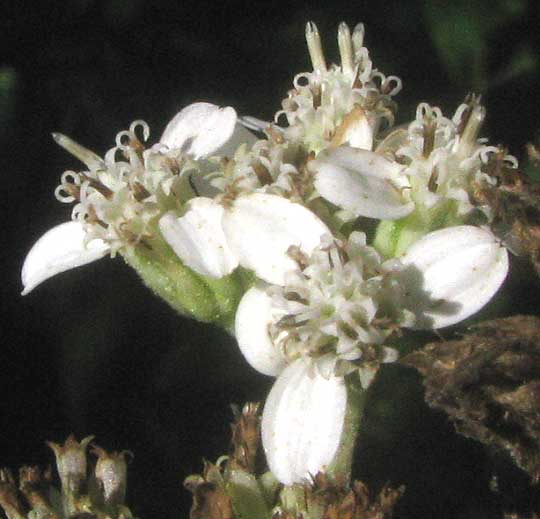
That picture shows five flower heads, each head bearing two to four flat, petal-like "ray flowers" surrounding a dozen or so tubular, five-lobed "disk flowers." Each brown item arising from a disk flower is composed of five anthers fused by their margins into cylinders surrounding the flowers' styles, or ovary "necks." The styles fork at their tips into two curved-back stigmatic areas -- where pollen germinates. These are all features of members of the enormous Composite Family.
One good field mark for Frostweed is that in its flower heads the ray flowers are not at all evenly spaced on the perimeter. In the last picture on the bottom flower head notice how three ray flowers crowd the left side but only one arises on the right. The combination of such asymmetrical flower heads with the brown anthers giving the clusters a salt-and-pepper look is distinctive of the species.
A shot showing the clusters' involucral bracts, which are especially long, hairy, and not much overlapping one another, is below:
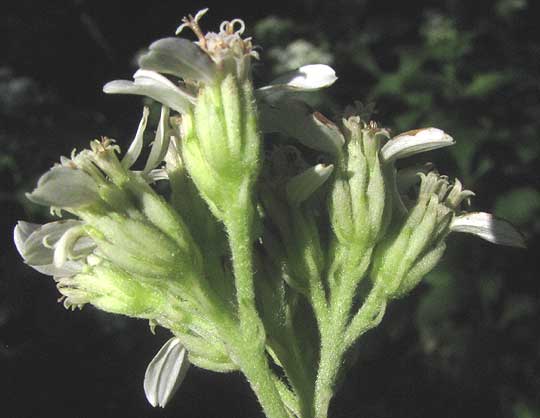
Another very distinctive feature of the species, as well as several other species in the genus, is that the stems are provided with green "wings" of leafy material, as shown below:
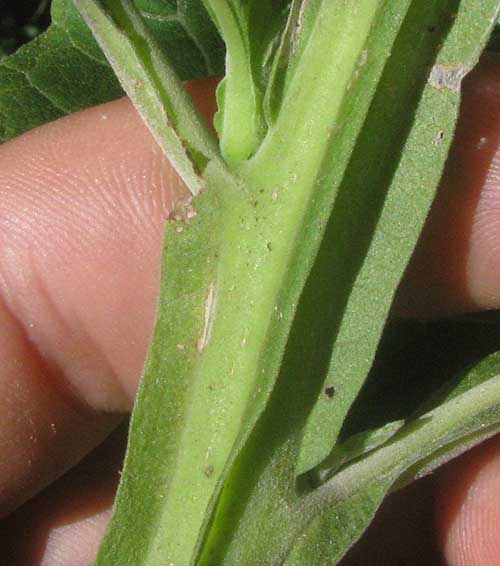
Probably those leafy wings have something to do with the "ice wings" developing during the first hard freeze. They're certainly responsible for one of the plant's more popular names, Wingstem.
Several traditional medicinal uses of Frostweed, or Wingstem, have been documented among Native Americans. Depending on the culture, the plant has been used as a gastrointestinal aid, a urinary aid, a laxative, an eye medicine, externally against joint pain, as an emetic, and for ceremonial uses.
Ecologically Frostweed is an important nectar provider. As I photographed the plant several butterflies of various species visited the flowers. In early morning if you find a place where lots of Frostweeds are flowering in the sunlight, the place will be alive with butterflies.
from the December 16, 2012 Newsletter issued from the valley of the Dry Frio River in northern Uvalde County, southwestern Texas, on the southern border of the Edwards Plateau; elevation ~1750m (~5750 ft); N29.62°, W99.86°; USA
FROSTWEED'S WINGS OF ICE
Back East I called the plant Wingstem, so I asked why it was called Frostweed here. I was told that on the morning of winter's first good freeze conspicuous white "wings" of ice emerge from the stem, something very pretty to see. This Tuesday, December 11th, we had our first freeze, with a dawn temperature of 27°F (-3°C). As soon as the sun was up I visited the nearest colony of Frostweed, where well before our freeze the plants had turned brown and dry. You can see the base of one Frostweed stem below:
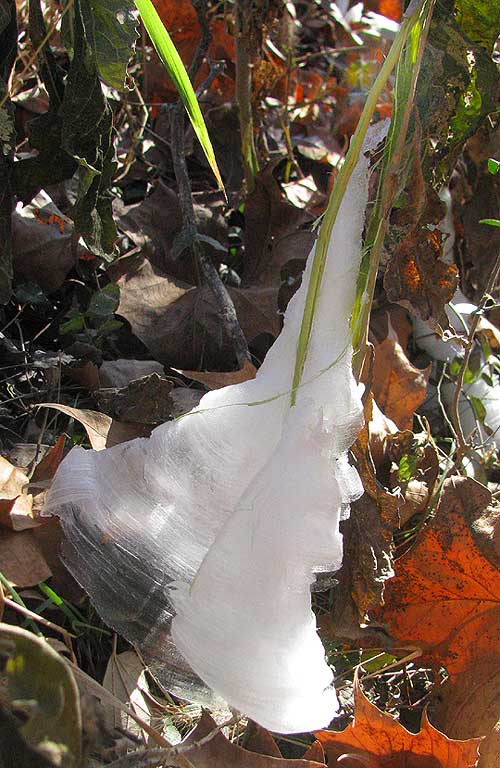
A close-up of another plant's ice wings bursting from a stem can be seen below:
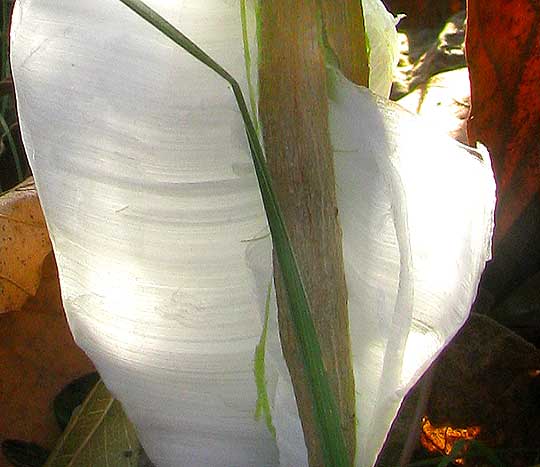
Very few other plants produce such wings of ice. I assume that Frostweed has this special feature because, as we saw in September, its stems naturally bear green, herbaceous "wings" along their lengths. One assumes that either beneath the vertical wings themselves or between them the stem is weaker than elsewhere. When the stem freezes, water inside it changes to ice, and since ice takes up more room than water, pressure builds up inside the stem, until finally the stem ruptures and ice escapes through the thin fractures lines.
Dr. James Carter at Illinois State University provides an interesting web page discussing the phenomenon, and provides pictures of long, twisting and curling ice ribbons extruding from a variety of situations at http://my.ilstu.edu/~jrcarter/ice/diurnal/extrude/.
from the September 21, 2006 Newsletter issued from Polly's Bend, Garrard County, in Kentucky's Bluegrass Region, USA
WINGSTEMS
One day this week it was chilly and drizzly until late afternoon. Then the clouds broke and deliciously warm sunlight slanted in from the west. I went to stand beside a kitchen-size patch of weeds that have survived because it was too rocky there for the bush-hogs to "clean them up."
The weed patch comprised a gracious mingling of two chest-high members of the Composite or Sunflower Family. One species, VERBESINA VIRGINICA, bore lots of smallish white blossoms while the other, VERBESINA ALTERNIFOLIA, displayed yellow, larger flowers (rays about an inch long). Note that both of these species belong to the genus Verbesina, so they are very closely related. About five Verbesina species are listed for North America's northeast quarter.
Each of our Verbesinas is known by several English names but I think of them as white-flowered and yellow-flowered "wingstems." That's because the stems of both species bear four fin-like ridges extending their lengths.
So, just imagine a perfect mingling of these two plants' yellow flowers and white ones, everything being lit from the side by the low, pre-dusk sun. The plants had been washed clean by the day's drizzle, and odors of fresh herbage and mud were being teased from the somber chill by warming sunlight.
Most transfixing, however, were the pollinators, ever so hungry after the day's inactivity enforced by chill and rain. A Monarch Butterfly skipped from flower to flower, taking in calories that'll be needed for the long migration soon to be made to Mexico. Many honeybees, carpenter bees and other kinds of wasps and bees I didn't know were busy. Orange-yellow Solder Beetles with a big, black spot on each wing wandered across the flowers feeding on pollen and nectar. I'd seldom seen so many creatures rushing to feed before the sun went down, and it was going down right then.
With sunlight warming one side of me I stood there visualizing the generous sun's radiant energy being captured through photosynthesis and stored among atomic bonds of wingstem carbohydrate, then that energy passing to the pollen- and nectar-eaters buzzing before me, then the pollinators going out and yielding up the energy in their bodies to birds who would eat them, to bacteria and fungi who would decompose their bodies, through arthropods and snails and slugs on down the line, out and out the energy flowing, being shared, fueling evolution, fueling untold numbers and forms of new life, new hope, new potentials, all blossoming from that very moment...
What fine members of the community are Verbesina virginica and Verbesina alternifolia, and how lucky we all felt that day that limestone rock had jutted from the ground nearby, keeping the bush-hog at bay.